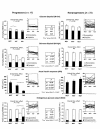The natural history of insulin secretory dysfunction and insulin resistance in the pathogenesis of type 2 diabetes mellitus
- PMID: 10491414
- PMCID: PMC408438
- DOI: 10.1172/JCI7231
The natural history of insulin secretory dysfunction and insulin resistance in the pathogenesis of type 2 diabetes mellitus
Abstract
The pathogenesis of type 2 diabetes involves abnormalities in insulin action, insulin secretion, and endogenous glucose output (EGO). However, the sequence with which these abnormalities develop and their relative contributions to the deterioration in glucose tolerance remain unclear in the absence of a detailed longitudinal study. We measured insulin action, insulin secretion, and EGO longitudinally in 17 Pima Indians, in whom glucose tolerance deteriorated from normal (NGT) to impaired (IGT) to diabetic over 5.1 +/- 1.4 years. Transition from NGT to IGT was associated with an increase in body weight, a decline in insulin-stimulated glucose disposal, and a decline in the acute insulin secretory response (AIR) to intravenous glucose, but no change in EGO. Progression from IGT to diabetes was accompanied by a further increase in body weight, further decreases in insulin-stimulated glucose disposal and AIR, and an increase in basal EGO. Thirty-one subjects who retained NGT over a similar period also gained weight, but their AIR increased with decreasing insulin-stimulated glucose disposal. Thus, defects in insulin secretion and insulin action occur early in the pathogenesis of diabetes. Intervention to prevent diabetes should target both abnormalities.
Figures


References
-
- Weir, G.C., and Leahy, J.L. 1994. Pathogensis of non–insulin-dependent (type II) diabetes mellitus. In Joslin’s diabetes mellitus. 13th edition. C.R. Kahn and G.E. Weir, editors. Lea & Febiger. Philadelphia, PA. 240–264.
-
- Bogardus, C. 1996. Metabolic abnormalities in the development of non-insulin-dependent diabetes mellitus. In Diabetes mellitus. D. LeRoith, S.I. Taylor, and J.M. Olefski, editors. Lippincot-Raven Publishers. Philadelphia, PA. 459 pp.
-
- DeFronzo RA. Lilly Lecture 1987. The triumvirate: B-cell, muscle, liver. A collision responsible for NIDDM. Diabetes. 1988;37:667–687. - PubMed
-
- National Diabetes Data Group. Classification and diagnosis of diabetes mellitus and other categories of glucose intolerance. Diabetes. 1979;28:1039–1057. - PubMed
-
- World Health Organization. 1985. Diabetes mellitus: report of a WHO study group. World Health Organization Technical Report Series, Volume 17. 45 pp. - PubMed
MeSH terms
Substances
LinkOut - more resources
Full Text Sources
Other Literature Sources
Medical

